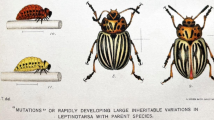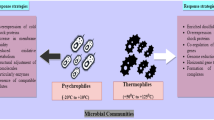Abstract
We have studied both the frequency and biogeographical distribution of the transposable DNA element mariner in natural populations of Drosophila simulans and the short-term evolutionary characteristics of mariner in experimental populations. The mariner element has been identified in natural populations of D. simulans from Africa, Europe, the Middle East, Japan, Australia, several Pacific islands, North America, and South America. Only four lines out of 296 were devoid of active mariner elements, as measured by the presence of functional mariner transposase. A slight correlation was found between the latitudinal coordinate of the collection sites and the level of mariner activity in the population; this correlation became highly significant in Australia where a cline in mariner activity was observed along the eastern coast of the continent. We also observed that wild-type laboratory strains kept for several years as small populations might lose mariner activity over time. Using experimental populations, we modeled what might happen when naturally occurring populations exhibiting high and low levels of mariner activity encounter one another. We found that active mariner elements either will tend to lose their activity over time and gradually become inactive or possibly will be lost from the population; in either case, this will lead to the pattern seen in this experiment of a significant loss of mariner activity over time.
Similar content being viewed by others
References
Boussy, I.A., 1987. A latitudinal cline in P-M gonadal dysgenesis potential in Australian Drosophila melanogaster populations. Genet. Res. 49: 11–18.
Brookfield, J.F.Y., 1996. Models of the spread of non-autonomous selfish transposable elements when transposition and fitness are coupled. Genet. Res. 67: 199–209.
Brunet, F., F. Godin, J.R. David & P. Capy, 1994. The mariner transposable element in the Drosophilidae family. Heredity 73: 377–385.
Capy, P., F. Chakrani, F. Lemeunier, D.L. Hartl & J.R. David, 1990. Active mariner transposable elements are widespread in natural populations of Drosophila simulans. Proc. R. Soc. Lond. B 242: 57–60.
Capy, P., A. Koga, J.R. David & D.L. Hartl, 1992. Sequence analysis of active mariner elements in natural populations of Drosophila simulans. Genetics 130: 499–506.
Capy, P., J.R. David & D.L. Hartl, 1992. Evolution of the transposable element mariner in the Drosophila melanogaster species group. Genetica 86: 37–46.
Chakrani, F., P. Capy & J.R. David, 1993. Developmental temperature and somatic excision rate of mariner transposable element in three natural populations of Drosophila simulans. Genet. Sel. Evol. 25: 121–132.
Charlesworth, B. & D. Charlesworth, 1983. The population dynamics of transposable elements. Genet. Res. 42: 1–27.
Daniels, S.B., I.A. Boussy, A. Tukey, M. Carrillo & M.G. Kidwell, 1987. Variability among 'true M' lines in P-M gonadal dysgenesis potential. Drosophila Inform. Serv. 66: 37–39.
Engels, W.R., 1989. P elments in Drosophila melanogaster, pp. 437–484 in Mobile DNA, edited by D.E. Berg and M.M. Howe. American Society for Microbiology, Washington, DC.
Engels, W.R., 1996. P elements in Drosophila, pp. 103–123 in Transposable Elements, edited by H. Saedler and A. Gierl. Springer-Verlag, Berlin.
Garza, D., M. Medhora, A. Koga & D.L. Hartl, 1991. Introduction of the transposable element mariner into the germline of Drosophila melanogaster. Genetics 128: 303–310.
Giraud, T. & P. Capy, 1996. Somatic activity of the mariner transposable element in natural populations of Drosophila simulans. Proc. R. Soc. Lond. B 263: 1481–1486.
Good, A.G., G.A. Meister, H.W. Brock, T.A. Grigliatti & D.A. Hickey, 1989. Rapid spread of transposable P elements in experimental populations of Drosophila melanogaster. Genetics 122: 387–396.
Hartl, D., 1989. Transposable element mariner in Drosophila species, pp. 531–536 in Mobile DNA, edited by D.E. Berg and M.M. Howe. American Society for for Microbiology, Washington, DC.
Hartl, D.L., E.R. Lozovskaya, D.I. Nurminsky & A.R. Lohe 1997. What restricts the activity of mariner-like transposable elements? Trends Gene. 13: 197–201.
Haymer, D.S. & J.L. Marsh, 1986. Germ line and somatic instability of a white mutation in Drosophila mauritiana due to a transposable genetic element. Develop. Genet. 6: 281–291.
Jacobson, J.W. & D.L. Hartl, 1985. Coupled instability of two X-linked genes in Drosophila mauritiana: germinal and somatic mutability. Genetics 111: 57–65.
Jacobson, J.W., M.M. Medhora & D.L. Hartl, 1986. Molecular structure of a somatically unstable transposable element in Drosophila. Proc. Natl. Acad. Sci. USA 83: 8684–8688.
James, A.C., R.B.R. Azevedo & L. Partridge, 1995. Cellular basis and developmental timing in a size cline of Drosophila melanogaster. Genetics 140: 659–666.
Kidwell, M.G., J.B. Novy & S.M. Feeley, 1981. Rapid unidirectional change of hybrid dysgenesis potential in Drosophila. J. Heredity 72: 32–38.
Kidwell. M.G., K. Kimura & D.M. Black, 1988. Evolution of hybrid dysgenesis potential following P clement contamination in Drosophila melanogaster. Genetics 119: 815–828.
Kiyasu, P.K. & M.G. Kidwell, 1984. Hybrid dysgenesis in Drosophila melanogaster: The evolution of mixed P and M populations maintained at high temperature. Genet. Res. 44: 251–259.
Knibb, W.R., 1982. Chromosome inversion polymorphisms in Drosophila melanogaster. II. Geographic clines and climatic associations in Australasia, North America and Asia. Genetica 58: 213–221.
Knibb, W.R., J.G. Oakeshott & J.B. Gibson, 1981. Chromosome inversion polymorphisms in Drosophila melanogaster. I. Latitudinal clines and associations between inversions in Australasian populations. Genetics 98: 833–847.
Lohe, A.R. & D.L. Hard, 1996. Autoregulation of mariner transposase activity by overproduction and dominant-negative complementation. Mol. Biol. Evol. 13: 549–555.
Lohe, A.R., D. De Aguiar & D.L. Hartl, 1997. Mutations in the mariner transposase: The D, D(35)E consensus sequence is nonfunctional. Proc. Natl. Acad. Sci. USA 94: 1293–1297.
Maruyama. K. & D.L. Hartl, 1991. Evolution of the transposable element mariner in Drosophila species. Genetics 128: 319–329.
Maruyama, K., K.D. Schoor & D.L. Hartl, 1991. Identification of nucleotide substitutions necessary for trans-activation of mariner transposable elements in Drosophila: Analysis of naturally occurring elements. Genetics 128: 777–784.
Medhora, M., K. Maruyama & D. Hartl, 1991. Molecular and functional analysis of the mariner mutator element Mos1 in Drosophila. Genetics 128: 311–318.
Nikitin, A.G. & R.C. Woodruff, 1995. Somatic movement of the miariner transposable element and lifespan of Drosophila species. Mutation Res. 338: 43–49.
Oakeshott, J.G., G.K. Chambers, J.B. Gibson & D.A. Willcocks, 1981. Latitudinal relationships of esterase-6 and phosphoglucomutase gene frequencies in Drosophila melanogaster. Heredity 47: 385–396.
Oakeshott, J.G., J.B. Gibson, P.R. Anderson, W.R. Knibb, D.G. Anderson & G.K. Chambers, 1982. Alcohol dehydrogenase and glycerol-3-phosphate dehydrogenase clines in Drosophila melanogaster on different continents. Evolution 36: 86–96.
Preston, C.R. & W.R. Engels, 1989. Spread of P transposable elements in inbred lines of Drosophila melanogaster. Prog. Nuc. Acids Res. Mol. Biol. 36: 71–85.
Robertson, H.M., 1995. The Tc1-mariner superfamily of transposons in animals. J. Insect Physiol. 41: 99–105.
Simmons, M.J., J.D. Raymond, M.J. Boedigheimer & J.R. Zunt, 1987. The influence of nonautonomous P elements in hybrid dysgenesis in Drosophila melanogaster. Genetics 117: 671–685.
Starmer, W.T., M. Polak, L.L. Wolf & J.S.F. Barker, 1998. Reproductive characteristics of the flower breeding Drosophila hibisci Bock (Drosophilidae) in eastern Australia: Genetics and environmental determinants of ovariole number. Evolution 52: 806–815.
Author information
Authors and Affiliations
Rights and permissions
About this article
Cite this article
Russell, A.L., Woodruff, R.C. The genetics and evolution of the mariner transposable element in Drosophila simulans: worldwide distribution and experimental population dynamics. Genetica 105, 149–164 (1999). https://doi.org/10.1023/A:1003760123429
Issue Date:
DOI: https://doi.org/10.1023/A:1003760123429




